Hoka Speedgoat 5
Stated Stack Height (Men’s): 33 mm (heel) / 29 mm (forefoot)
Test Location: Marin, CA
Test Duration: 135 (so far)
Stated Heel-to-Toe Drop: 4 mm
Stated Features:
- Double layer jacquard engineered mesh upper
- A late stage “Meta-Rocker” for better energy return
- A lay-flat gusseted tongue and reinforced heel collar
- A compression-molded foam midsole
- A Vibram Megagrip outsole with 5 mm “Traction Lugs”
Stated Weight per Shoe (US Men’s Size 9): 292 g / 10.3 oz
Blister Measured Weight per Shoe (US Men’s Size 8.5):
- Shoes + Laces: 271 g (left) & 267 g (right)
- Insoles: 14 g (left) & 14 g (right)
- Total: 285 g (left) & 281 g (right)
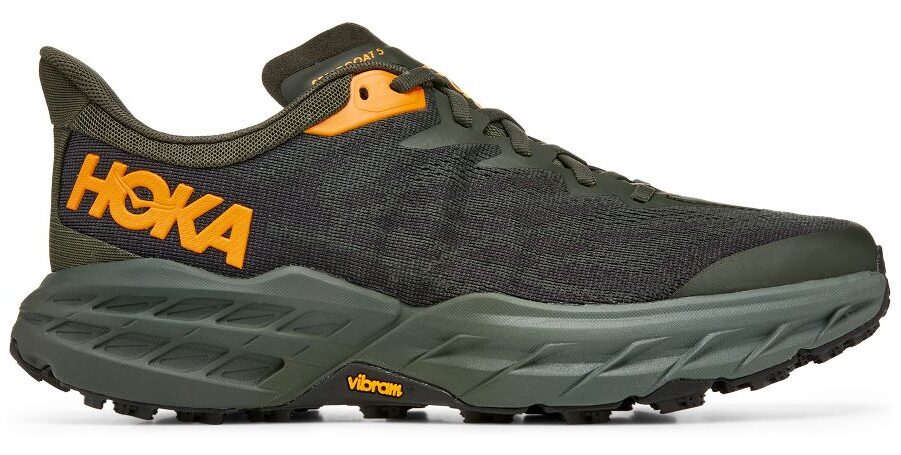
Size Tested: US Men’s 9 / EU 43
Reviewer: 5’9”, 150 lbs / 175 cm, 68 kg
MSRP: $155
Intro
Hoka was one of the fastest growing footwear brands of last year, a superlative that tracts with their near-decade long trajectory from niche to mainstream. This rapid ascendency is testament in large part to their radical design philosophy, one characterized by aggressive risk taking that has resulted in some true duds (remember these guys?). However, Hoka’s willingness to blow past conventions and adopt an original aesthetic of their own has also produced a handful of shoes, both for road and trail, that have become archetypal in the footwear space, as close to household names as you’re going to get.
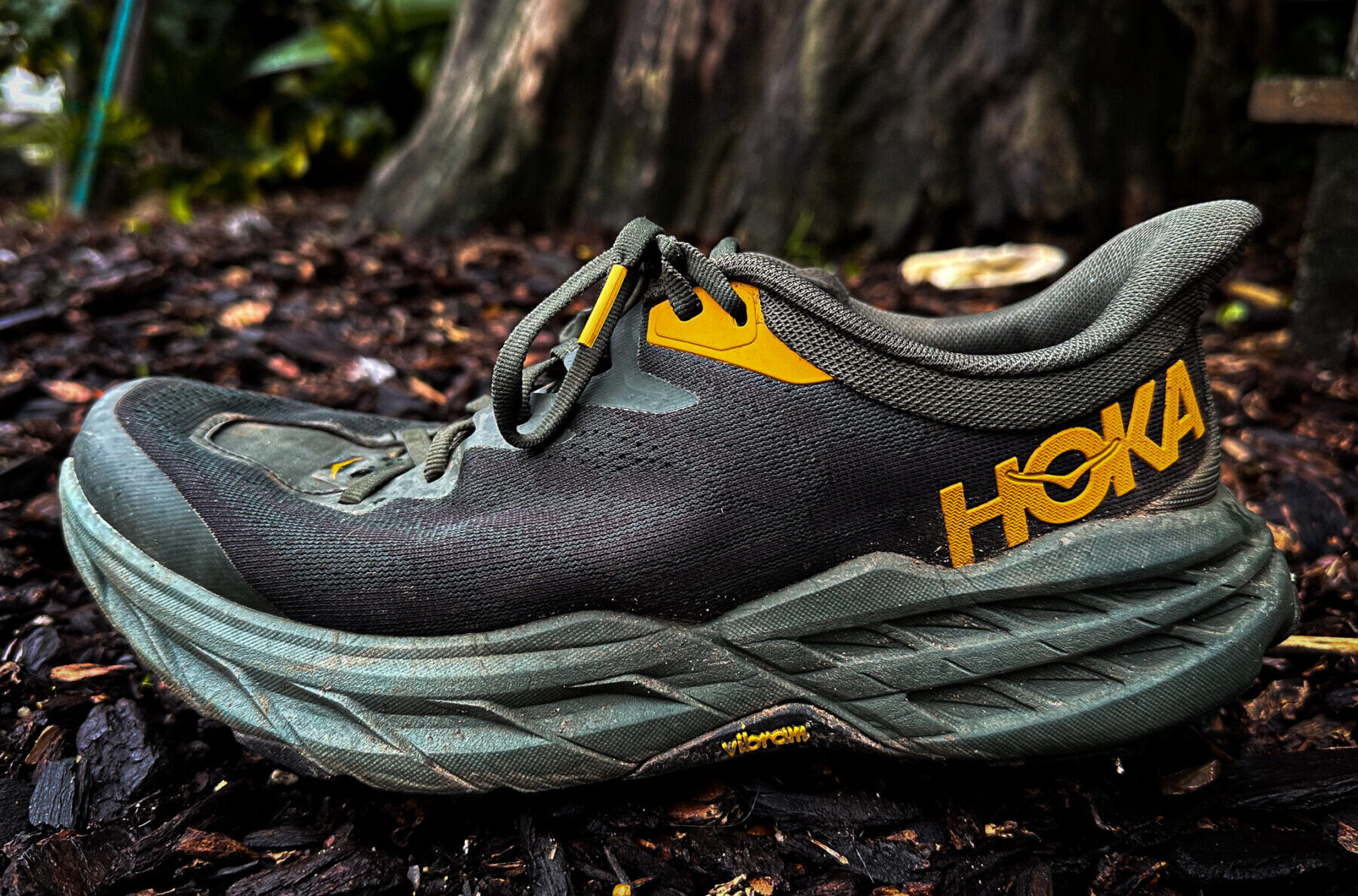
Fit & Features
Much of the Speedgoat’s identity, what makes it a true measuring stick other shoes are often held up against, has always been the feeling and design of its midsole. Abundantly cushioned, airy, and with a pronounced rocker geometry, the compression-molded EVA foam midsole Hoka uses in the Speedgoat 5 is the least altered section of the shoe, a carry-over from the Speedgoat 4 that I expect to be well received. The upper and outsole, however, mark a departure from past versions.
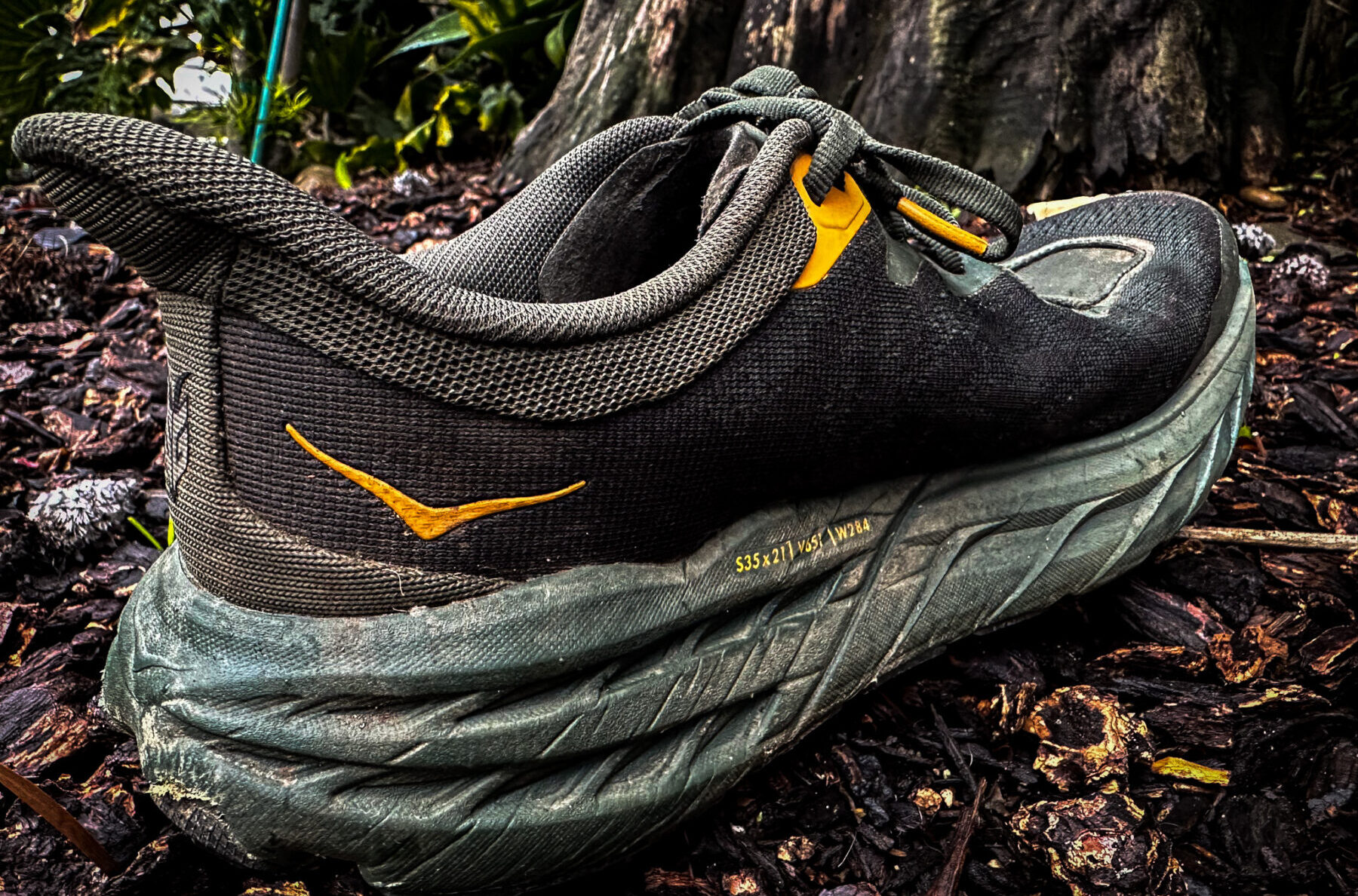
In recent years, Hoka has conspicuously drifted away from the trend of using heavily overlaid uppers and has instead moved toward those constructed from engineered jacquard mesh. Much of the criticism lobbed at the Speedgoat 4 targeted its rigid upper, which had a tendency to crease at flex-points over the toe box and lead to irritation. The switch to a double layer of mostly overlay-free jacquard in the Speedgoat 5 immediately addresses this issue by adding flexibility to the shoe without sacrificing snugness. The mesh Hoka uses is sturdier than what’s featured on the Tecton X, and while perhaps slightly less durable than an upper laminated with sections of TPU, still feels plenty protective. This move also helps reduce overall weight, a metric Hoka is clearly cognisant of. For reference, here’s how the Speedgoat 5’s stated weight compares to the stated weights for some other similar models, including the Speedgoat 4. All weights are based on a US Men’s Size 9.
260 g / 9.2 oz — Salomon Ultra Glide
260 g / 9.2 oz — Nnormal Tomir
284 g / 10.0 oz — Topo Athletic Mtn Racer 2
289 g / 10.2 oz — Topo Athletic Ultraventure 3
292 g / 10.3 oz — Hoka Speedgoat 5
292 g / 10.3 oz — Saucony Xodus Ultra
295 g / 10.4 oz — Hoka Mafate Speed 4
298 g / 10.5 oz — Brooks Cascadia 16
300 g / 10.5 oz — La Sportiva Jackal
306 g / 10.8 oz — Hoka Speedgoat 4
310 g / 10.9 oz — La Sportiva Akasha II
310 g / 10.9 oz — Dynafit Ultra 100
312 g / 11.0 oz — Brooks Caldera 6
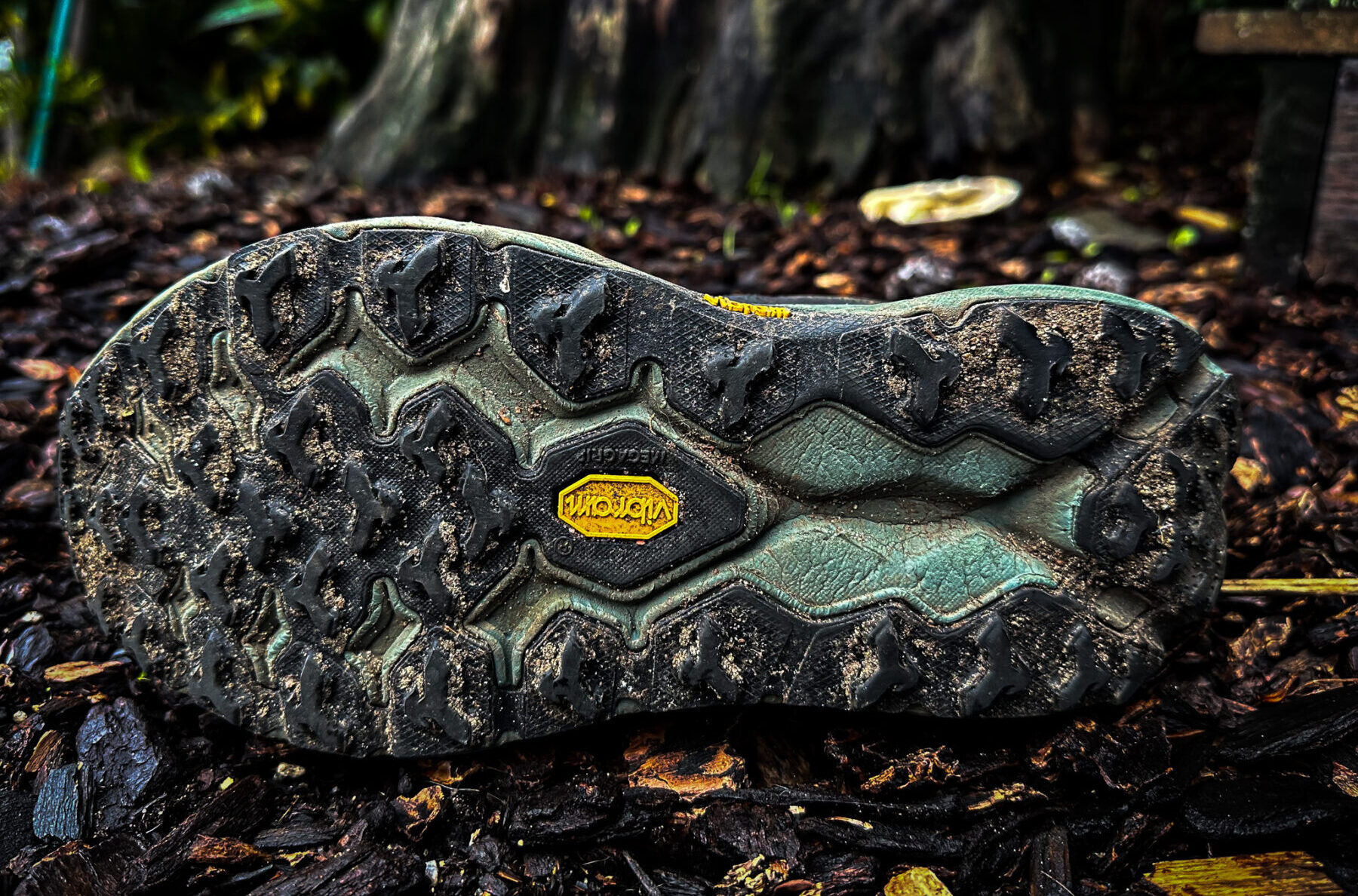
A few other things worth calling out on the Speedgoat 5’s redesigned upper include the shoe’s lay-flat, partially gusseted tongue and newly bolstered heel collar with extended heel tab. While I think these features are secondary to the switch to jacquard mesh in terms of overall significance, they’re warmly received additions that do make the Speedgoat 5 quite a bit more comfortable, from heel to toe, than the Speedgoat 4, at least for my preferences. The tongue avoids crowding the top of my foot and the flared heel collar gently swaddles my Achilles.
I’m sure some will argue that the otherwise accommodating fit of the Speedgoat 5, which is largely helped by the details listed above, is undone by the angular appearance of its toe box. Fair enough, the shoe’s sharply tapered silhouette suggests as much, though so far I’ve found it to be plenty accommodating in the forefoot, even for my slightly wide feet. For those folks who do favor more of a foot-shaped toe box, the Speedgoat 5 is available in wide (EE) sizes.
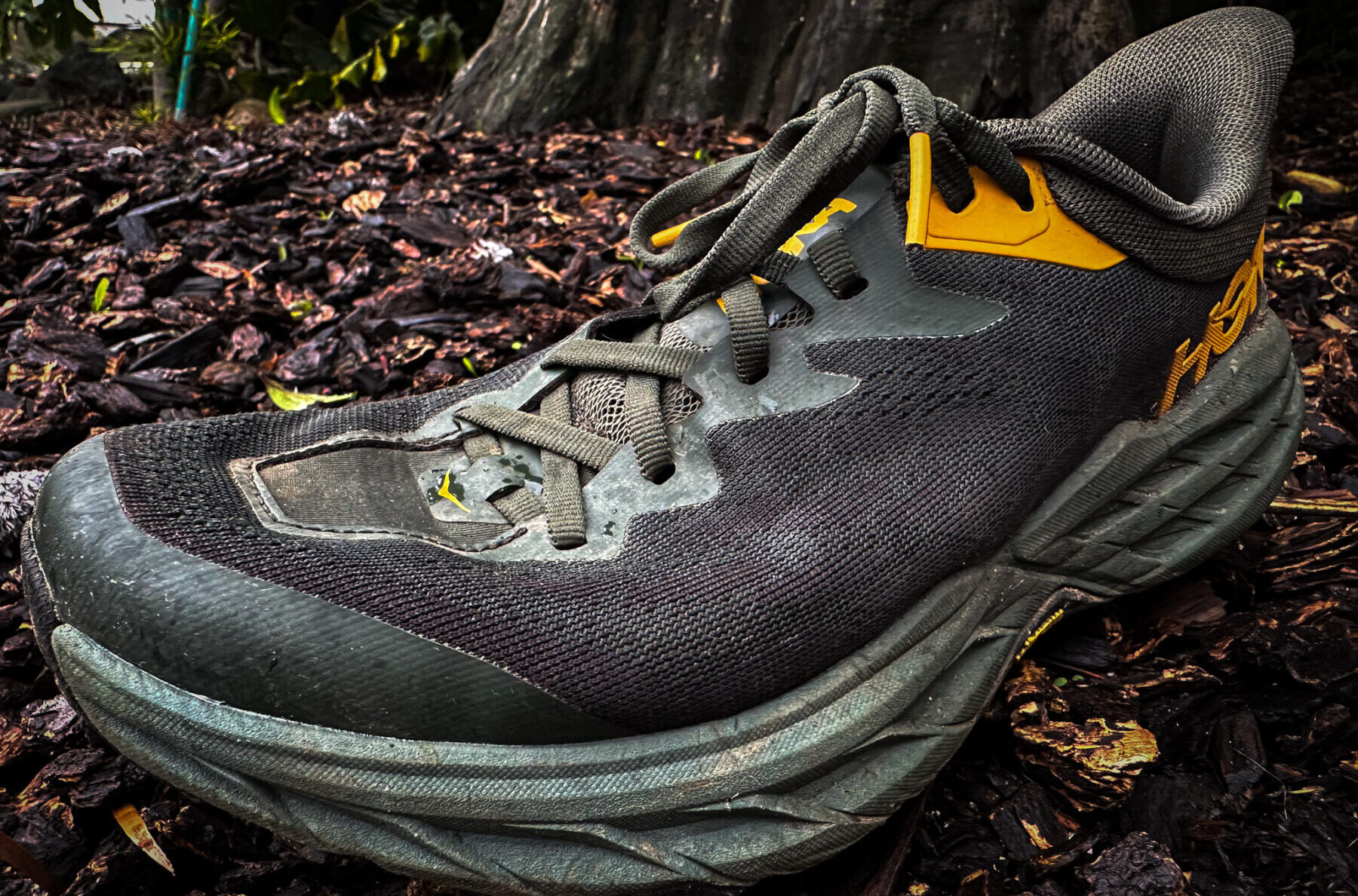
Some Questions / Things We’re Curious About
- How will the weight-saving measures Hoka takes in the Speedgoat 5 (e.g., jacquard mesh upper, lighter midsole compound, and trimmer lug orientation) affect the shoe’s overall durability?
- In my experience, the fit of most Hoka models changes wildly over the course of their first 100 miles, more so than shoes from other brands. Will this hold true for the Speedgoat 5?
- The Speedgoat line has a reputation for being incredibly versatile across all types of terrain and distances — a veritable “workhorse,” you could say. Will this new version carve out a more defined role, given all of its updates?
Bottom Line (For Now)
The direction Hoka has taken their shoe design has changed quite a bit since the release of the first Speedgoat, for better and for worse. As the company has expanded, they’ve broadened their scope immensely. While success could have led them to neglect the evolution of some of their flagship models like the Speedgoat in favor of new projects, Hoka has stayed loyal to what originally put them on the map for many. At least by early indications, the Speedgoat 5 continues the line’s reputation as one of the best “do-it-all” options on the market. Whether or not its hot start can be sustained over the long haul will be a major focus in our upcoming review.
FULL REVIEW
Intro
One of the hallmarks of a legacy footwear brand is the ability to be represented by a particular model of shoe, a defined silhouette that’s conjured in the imagination whenever the name of said brand is mentioned. Converse has its Chuck Taylor, Nike has its Pegasus, Adidas has its Samba, and so on, all of which to some degree have become cultural touchstones in their own rights. Reaching this type of synecdoche — where a specific shoe is meant to stand in and signify its maker — is rare, but I think the case can be made that the Hoka Speedgoat, now in its fifth iteration, is approaching that very status.
How apt that a model that so thoroughly embodies every tenet of Hoka’s original design philosophy, from gaudy colorway to thick, pillowy midsole, has endeared itself to the trail running world to the extent that the Speedgoat has. The shoe is a fixture, and as an icon, runs the risk of becoming “fixed”; even the slightest modification between generations is placed under magnified scrutiny when compared to changes across less tenured models.
Yet, in an increasingly competitive footwear space with a growling hunger for new tech and innovation, Hoka can’t afford to let the Speedgoat idle; it too must evolve. How well Hoka splits the gap between completely sitting on their hands when it comes to updating the Speedgoat, offering up something relatively pat and safe, or, on the other hand, choosing to radically overhaul the model entirely, remains to be seen. Well, after eclipsing the 100-mile mark in the latest Speedgoat 5, I think Hoka has done well to find a healthy middle ground between both extremes. In this review, I’ll provide some reasons why I think Hoka’s flagship trail model continues to improve upon itself with each iteration.
Fit
The early popularity of the Speedgoat was a boon for Hoka; the shoe still perennially ranks as one of the best reviewed models on the market, year after year. But with this success comes corresponding levels of criticism. Though shouted by a vocal minority, complaints about past iterations of the Speedgoat have occasionally drowned out some of its praise. Every one of the first 4 versions of the shoe was called too narrow by some camps, too rigid by others, and while I personally never felt inhibited by any of the model’s previous lasts, I do think these complaints had some credibility. The Speedgoat is positioned as a hyper-versatile trail option for just about every type of runner, and this degree of accessibility is part and parcel to its success. It also happens to put Hoka in a super difficult position. The Speedgoat needs to have a near-universal fit — neither too narrow, nor too wide, too loose, nor too tight — to maintain its mass appeal.

In the Speedgoat 5, Hoka attempts to placate an incredibly diverse spectrum of foot shapes and fit preferences through an interplay between a neutral to narrow last (reminiscent of the Speedgoat 4’s) and an overhauled jacquard upper. The shoe angles in at the midfoot, providing a decent amount of arch support, before continuing to sharply taper forward through the forefoot, where it terminates in an arrowhead-shaped toe box. Though this description might suggest a pretty narrow fit, the Speedgoat 5 makes up width in the form of its lightweight mesh upper, which grants feet room to splay while still remaining structured enough to hold everything together at faster paces (much to the credit of the lay-flat gusseted tongue). The shoe’s midsole also fans out a noticeable amount from the footbed to the outsole, adding to the platform’s overall surface area and helping to stabilize its higher stack height. I’d also add that, anecdotally, almost every pair of Hokas I’ve worn to date have widened out considerably once properly broken in (~20 to 30 miles). The airy EVA foam composition the brand is notorious for using in many of their highly cushioned models (e.g., the Speedgoat, Clifton, Challenger ATR, and Bondi) is predisposed to “pancaking” out a bit once subjected to load for an extended period, which, while potentially reducing energy return, does often make the shoe more accommodating for folks with wider feet, myself included.
A notable new addition to the Speedgoat 5 is its restructured heel collar, now featuring Hoka’s signature elfin pull tab that they’ve used across their lineup for the past couple of years. As a shoe that anticipates having to handle a lot of vertical change on trail, the Speedgoat 5 is tasked with supporting the heel / Achilles while climbing in a way that’s not intrusive when descending or while running on the flats. To account for this, they’ve supplied heavy padding around the heel collar itself, which swaddles the Achilles before gently flaring out into a pull tab. Much like the front of the shoe, this construction allows for enough play to be comfortable as well as supportive. If you’ve become skittish after suffering from Achilles issues in the past, I think the Speedgoat’s heel design and “Meta-Rocker” midsole geometry (which I’ll touch on more later) should be enough to assuage your fears.
Weight
As is the case with most shoe updates, the Speedgoat 5 lost some weight. The 14 g Hoka stripped mostly come from the upper, which is noticeably free of the TPU overlays that dominated the previous versions. The jacquard mesh Hoka uses instead sneaks the shoe under 300 g for a US Men’s Size 9 and adds more of a performance feel. While likely not quite nimble enough to be considered a race-day option for faster efforts, the Speedgoat 5’s trimmer stature does broaden how it can be used, especially for folks who shirked the Speedgoat 4 for being too clunky at higher intensities. For more context, here’s how the Speedgoat 5’s stated weight compares to the stated weights for some other similar models, including its previous iteration. All weights are based on a US Men’s Size 9.
260 g / 9.2 oz — Salomon Ultra Glide
260 g / 9.2 oz — Nnormal Tomir
284 g / 10.0 oz — Topo Athletic Mtn Racer 2
289 g / 10.2 oz — Topo Athletic Ultraventure 3
292 g / 10.3 oz — Hoka Speedgoat 5
292 g / 10.3 oz — Saucony Xodus Ultra
295 g / 10.4 oz — Hoka Mafate Speed 4
298 g / 10.5 oz — Brooks Cascadia 16
300 g / 10.5 oz — La Sportiva Jackal
306 g / 10.8 oz — Hoka Speedgoat 4
310 g / 10.9 oz — La Sportiva Akasha II
310 g / 10.9 oz — Dynafit Ultra 100
312 g / 11.0 oz — Brooks Caldera 6
I think Hoka could have easily reduced the Speedgoat 5’s weight even further, but I’m glad they didn’t. The model has, in my opinion, always worn its size well, and I’m fine lugging around a few extra grams on my feet when wearing a shoe meant to be as industrious and versatile as the Speedgoat.
Upper
At some point within the past year or two, Hoka decided to mostly do away with the use of heavily overlaid TPU uppers on their trail shoes in favor of jacquard mesh. I wrote about this departure in my review of the Tecton X, a carbon-plated hyper-shoe that was one of their first models to feature the material. In that example, I rewarded the use of jacquard mesh, feeling like it provided the shoe with a comfortable and secure fit; however, I also was pretty critical of its single-layer structure, which I thought lacked resilience.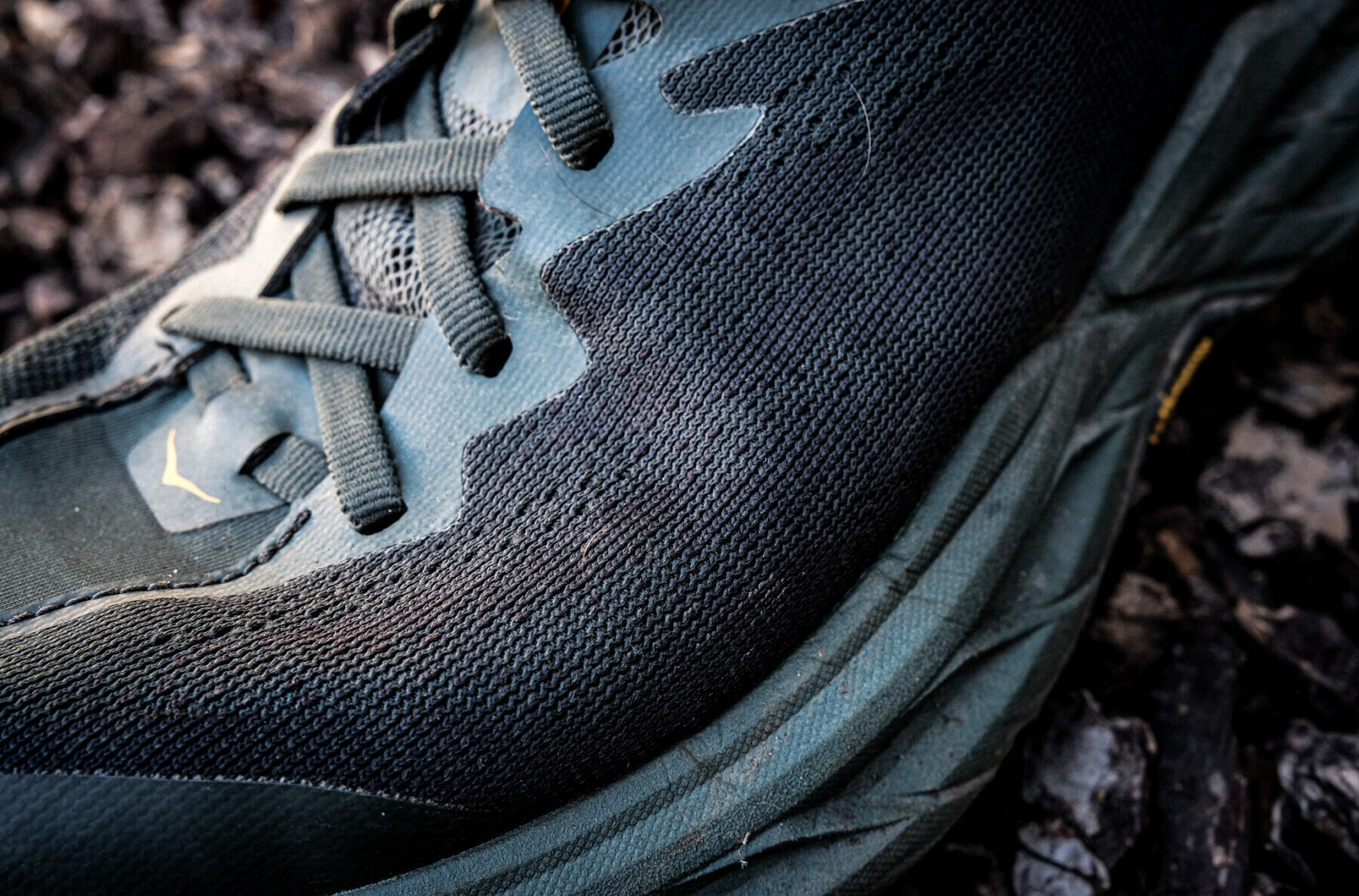
The Speedgoat 5’s upper receives a similar treatment, but benefits from multiple layers of jacquard mesh instead of just a single one. This will likely be the most unfamiliar feeling aspect of the shoe for longtime Speedgoat enthusiasts, but I think it’s a welcomed change. Much of the criticism aimed at the Speedgoat 4 landed on the rigidity of its laminate-heavy upper, which had a tendency to crease at flex-points over the toe box and ventilated poorly. The new mesh is more forgiving, crease-resistant, and breathes better, attributes that are also helped by the substitution of the plastic overlay on top of the Speedgoat 4’s toe box with more permeable stretch fabric in the current version. The addition of a lay-flat gusseted tongue supplements the overall less-structured mesh upper by bracing the midfoot with padded material. I never felt like the shoe experienced any dropoff in fit security despite the absence of overlays. I’m sure there’ll be a few who call out this more minimal approach as somehow taking away from the Speedgoat 5’s protectiveness / durability, but the front of the shoe is still guarded by a sizable toe rand and a toe cap and Hoka consciously uses multiple layers of mesh for this very reason, so I have a hard time buying that argument.
As I commented on in the “Fit” section of this review, Hoka restructures the Speedgoat 5’s heel collar in a substantial way. Not only is it much more plushly cushioned than in past iterations, but it also rises quite a bit higher, flaring out into a convenient pull tab as it climbs further up the Achilles. I felt like this format hugged the back of my foot in a way that kept it in place regardless of terrain but also allowed it to micro adjust to changes when I went from running uphill to descending, or vice versa. Again, for a shoe intended as a do-it-all trail option for everyone from entry level runners to folks crushing big miles in the backcountry, nailing the heel collar design is pivotal to the Speedgoat 5’s overall success, and I think Hoka did just that.
Midsole
DNA is found in the nucleus of the cell, and for the Speedgoat 5, that nucleus takes the form of its midsole. In my opinion, Hoka has always been able to nail the durometer (i.e., hardness) of the EVA foam they use in the Speedgoat line; it’s never as flimsy and forgiving as the composition they use in many of their road shoes, nor does it possess the same inflexibility and sharpness as their race ready “PROFLY-X” foam. No, the sensation of the Speedgoat’s midsole is somewhere nestled in between, ready to kick back energy in each stride but not before dampening impact first, regardless of pace. It cruises on smooth trails and has enough full-bodiedness to hold up well on really rough terrain without feeling sloppy. The Speedgoat 5 maintains this streak by carrying over a lot of the same elements found in the ever-popular Speedgoat 4.
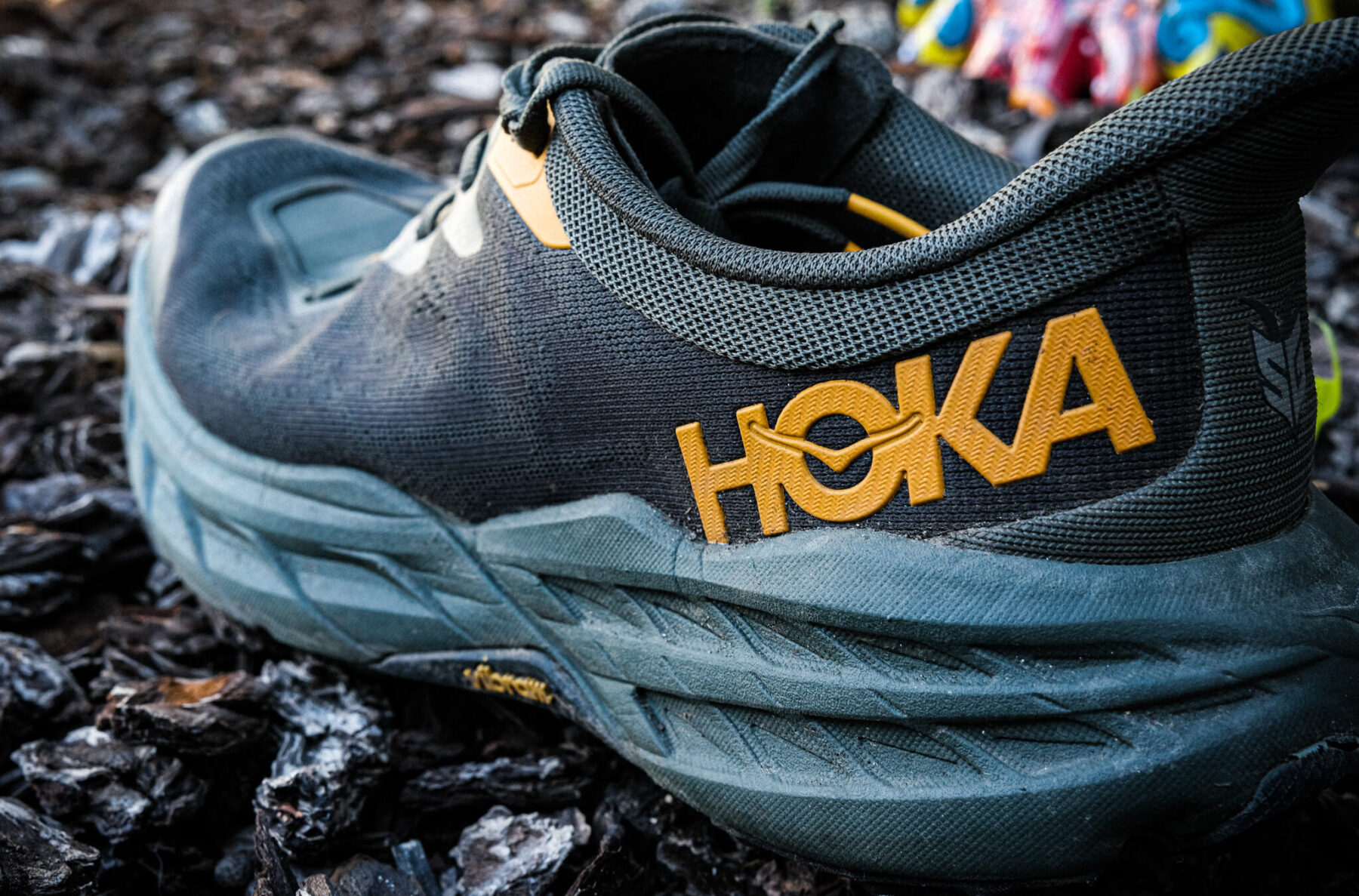
Hoka claims that the foam compound they use in the Speedgoat 5 is lighter than what is used in past iterations of the shoe, and on foot, I noticed the ride felt reminiscent of the since-defunct Speedgoat EVO. However, other than a slightly altered composition, the midsole is definitely one of the least touched areas of the shoe in this update and a demonstration of restraint I really want to reward. Hoka’s signature Meta-Rocker profile still encourages an energy efficient stride by rolling the foot forward upon landing; the shoe’s midsole thickness still easily supplies enough cushion for runs of any distance and underfoot protection for the toughest of trails; and its platform is still wide enough at ground level to stabilize its 33 mm / 29 mm of stack height.
You’ll usually hear the Speedgoat used as a reference model that other shoes are measured against in running circles, a testament to just how paradigmatic of a model it has become. “This is like X’s version of the Speedgoat,” and so on. For my money, the closest comparisons I’ve found in terms of ride / performance include the Salomon Ultra Glide, Brooks Caldera 6, and the Scarpa Spin Infinity, but none of those candidates strike the rare balance between smooth energy return and impact softening that Hoka is able to tease out of the Speedgoat 5’s midsole.
If you’re looking for a trail shoe that’s amply cushioned, encourages more of a midfoot strike, and has a balanced ride that nearly every major shoe brand has tried (and often failed) to replicate, save some time and try on a pair of the Speedgoat 5.
Outsole
A defining feature of the Speedgoat has always been its Vibram outsole; for Hoka to break that marriage in the Speedgoat 5 in favor of a different rubber compound would be sacrilege. Perhaps recognizing this, they’ve only slightly updated the shoe’s tread from its predecessor in the Speedgoat 4, but they’ve done so in a way that I feel is significant enough to call out.
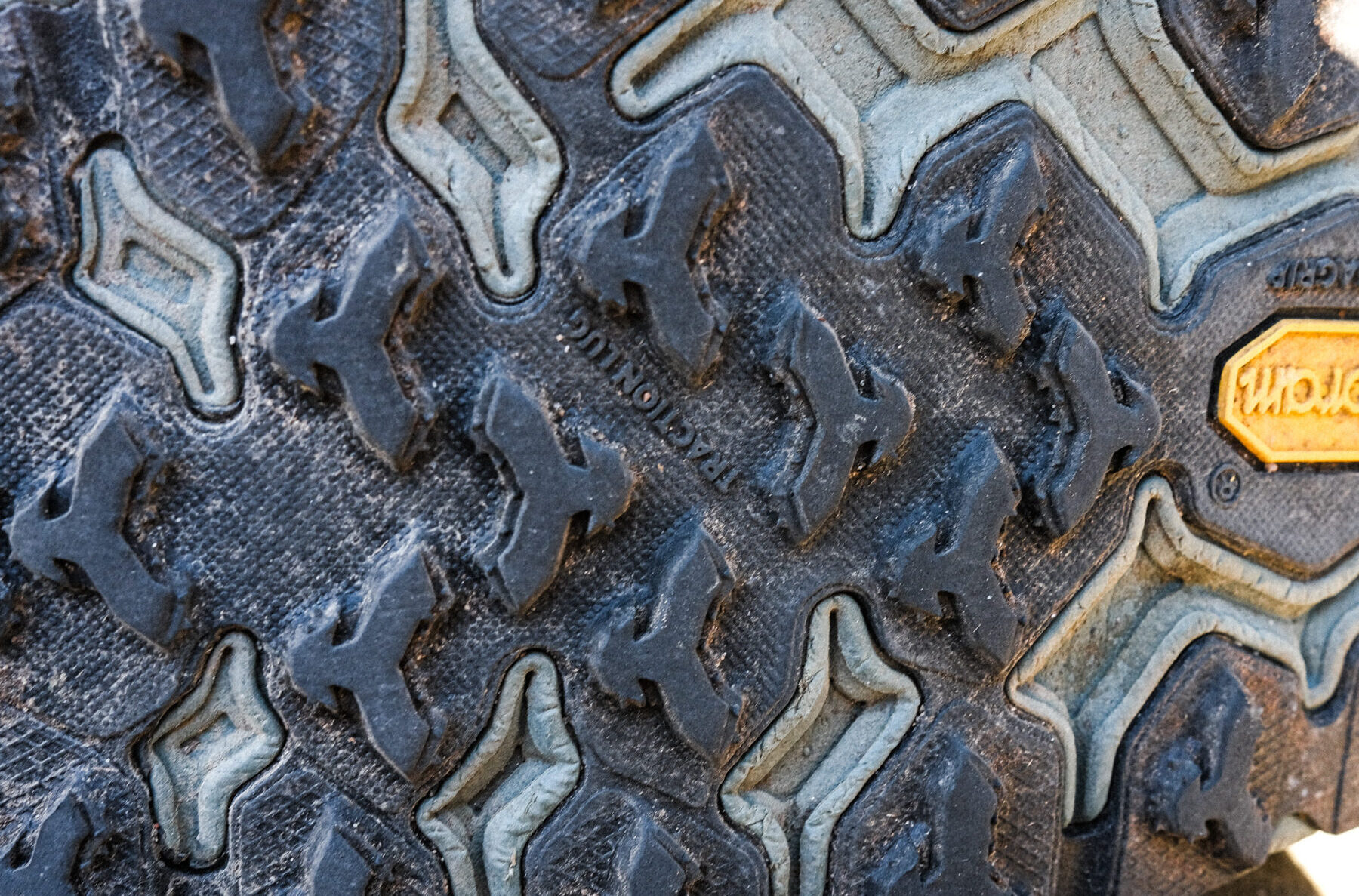
The Speedgoat 5 features a full-length Vibram “MegaGrip” outsole that, at first glance, looks unchanged. An array of familiar 5 mm grippy, barb-shaped lugs spread from a heavily concentrated patch under the forefoot to the heel counter’s rear-facing lugs, forming a pattern designed to provide multi-directional traction on loose surfaces and adequate braking power when running downhill. Hoka’s innovation takes place on a granular level. They’ve replaced their standard lugs with new “Traction Lugs,” which have a terraced shape to increase surface area and lead to better ground purchase. While a minor change, I do think the redesign — Hoka essentially gave their lugs, lugs — pays dividends on slick terrain, where I felt the Speedgoat 5 shed mud quite a bit better than the Speedgoat 4. This advantage is at the expense of its road performance, an area the shoe definitely struggles in because of how aggressive its outsole is. So if you’re looking for a true road-to-trail model, I’d point you in the direction of the Hoka Challenger 7 instead.
On Trail
I came to the Speedgoat 5 more out of curiosity than need. I wanted to see how Hoka handled updating such a precious model, whether they played it safe to avoid controversy and updated the shoe on a low-risk cosmetic level, or if they approached it more boldly and experimented at the expense of potentially incurring the wraith of a livid fanbase resistant to change. As it turns out, I think Hoka managed to accomplish both, and the Speedgoat 5 inserted itself into the hole left in my shoe rotation by the Speedgoat 4 without much friction at all.
Over the course of my testing period, I took the shoe out anytime I knew I was going to be on my feet for more than 2 hours. While I doubt most people will save the Speedgoat 5 for this role, I preferred to go with lower-stack options on my shorter runs, mainly for efficiency and to work on strengthening my intrinsic foot muscles. Using the Speedgoat 5 primarily for medium to long-distance runs revealed quite a bit about it, painting it in a light I’m not sure I would have fully appreciated otherwise. The shoe’s ride and fit felt impressively consistent as more miles went by. In my experience, this is pretty atypical. Most model’s I’ve worn with 30+ mm of stack height tail off in the amount of energy return they’re able to provide after, say, 90 minutes or so. Aided by its rockered profile, the reformulated EVA that Hoka uses in the Speedgoat 5’s midsole kept me moving forward as my legs fatigued.
One of the benefits of testing trail shoes in the Bay Area — Marin County, specifically — is that I’m able to run on a slew of different surface types over the course of a single run. This advantage was magnified by the fact that most of the efforts I wore the Speedgoat 5 on tended to be quite lengthy (up to 25 miles). The shoe gobbled up groomed fire roads with ease and happily transitioned onto buffed-out singletrack. I took rockier, more technical terrain a bit more deliberately than I normally would in a model with better ground feel, but considering I encountered these stretches in the context of a naturally slower-paced long run, it didn’t subtract from my performance much.
I’m fortunate enough to have a pretty expansive selection of shoes at my disposal. This allows me to be picky when it comes to building out my quiver, a lineup of 3-4 models I’ve been really reluctant to change for a while now. But at this point, it’d be nonsensical for me not to include a pair of the Speedgoat 5. Though I’ll likely use it predominantly for bigger days mostly on trail, it’s earned its position as something like a security blanket, a shoe I’ll default to if nothing else quite fits the bill. Through five iterations, Hoka still has my trust.
Durability
As the Speedgoat continues to get lighter, I’ve had my concerns about how this obsession with weight, which is endemic in the footwear industry, would affect the shoe’s long-term durability. Based on my experience working in running stores, the Speedgoat is likely the only pair of trail shoes a lot of runners will own, making its ability to hold up to daily abuse all that more important. Well, if you allow me to make some inferences after my first 135 miles, I don’t think the changes Hoka has made to save a dozen or so grams will have much of an impact on how long the Speedgoat 5 will last, for most folks. The new midsole composition has yet to feel like it’s beginning to pack-out, the Vibram outsole is holding up against abrasion much as you’d expect, and I’ve avoided any issues with the shoe’s jacquard mesh upper aside from some minimal stretching. As always, if anything changes down the line I’ll be back with updates.
Who’s It For?
Despite notable changes, the Speedgoat 5 is still a shoe for just about every type of trail runner, and that’s very much by design. The metaphorical weight its name carries and its mainstream popularity will attract folks just getting into the sport, who will likely derive a great deal of joy out of using it as a daily trainer. At the same time, more tenured runners who have been wearing versions of the Speedgoat for years for everything from mountainous long runs to ultras shouldn’t be disappointed by the latest iteration, which manages to retain the line’s “workhorse” identity while still offering up something new and noteworthy. And for those of you concerned about the Speedgoat 5’s tapered toe box, the shoe is available in Wide (EE) sizes.
Bottom Line
With a practiced hand, Hoka continues to refine the Speedgoat, their flagship trail shoe, in ways that incorporate new technologies only where they’re needed. The model’s fifth iteration reflects a delicate compromise between bold updates and carryover from the past, all of which add to the shoe’s decorated legacy as a true “do-it-all” option. There’s a reason the Speedgoat is perennially used as a benchmark other shoes are compared to, a position that says quite a bit about its enduring reputation as one of the best trail shoes out there. This latest edition doesn’t upset that standing, so whether you’re a longtime Hoka devotee or just looking for an option that covers all your bases (and then some), you have plenty of reasons to go try on a pair of the Speedgoat 5.





How do you think these would be for through hiking?
Hey John,
The Speedgoat has been a popular option for thru-hiking for many years and the changes to the latest iteration do nothing to buck that trend. My only concern would be with the Speedgoat 5’s high stack height — if you’re carrying a super heavy pack, wearing a shoe with a wider last, lower to the ground, or both, might give you a bit more stability.
For what it’s worth, my thru-hiking shoe of choice is the Altra Olympus 5.
Matt
how does it handle roads? For example, I start my runs on road for a short time, hit the trails, then hit roads for 2km to finish. Would I just wear down the lugs? or can it handle i?
Coming from a long history of more minimal shoes (S\Lab Sense, MT110, Superiors), Speedgoats have quite literally changed my running completely.
I am faster, recover way better and hardly, if at all slower on the techy downhill stuff.
I’ve found them super versatile and not slow at all on the road.
One can definitely feel / “hear” the lugs on tar, but they still turn over beautifully.
I ran a mixed surface 30km run this weekend and couldn’t help myself speeding up for the last 5k of tar to get home.
Great shoes. For my feet, I have to use the heel lock lacing to really lock in the heel, but otherwise great fit. Feel light running with fast and easy turnover. I use them for trail running and hiking. Tread pattern excellent except in the super wet. For hiking, they are great and reduce leg fatigue/have enough padding to avoid feet getting banged by rocks/feet don’t hurt after long days. My only comment re hiking would be they wouldn’t be first choice for scrambling type days, due to stack height/thick sole making them a bit unstable on true technical terrain… Otherwise I love them.